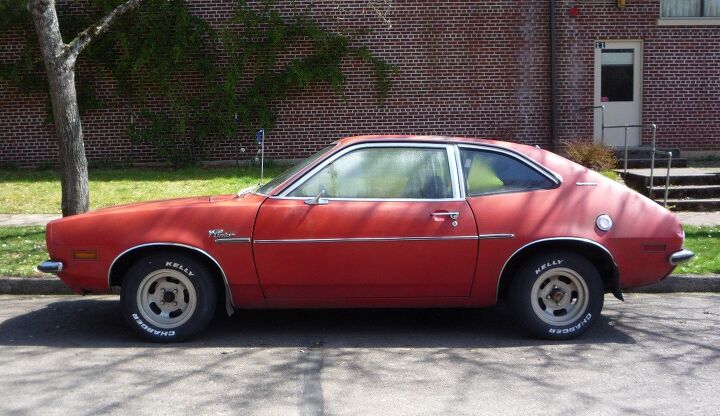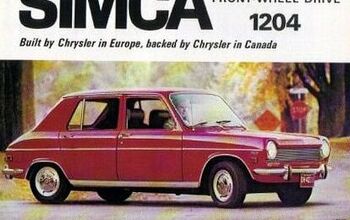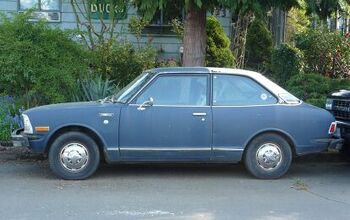Curbside Classics: 1971 Small Cars Comparison: Number 4 - Ford Pinto

Curbside Classics takes you back to 1971 for a virtual comparison test of six small cars, based (and partly borrowed) from a C/D test.
Few cars are more polarizing than the Pinto (except the Prius, of course). Commonly derided for its exploding gas tank and general crappiness, other folks found (still find) it to be cheap, fairly reliable transportation with a variable fun quotient, depending on its configuration. Sometimes, cars develop their reputations later in life, but the underdeveloped Pinto was pretty much an open book right from the beginning. A children’s book, at that. The Pinto should have been called Foal; it was a baby car.
Although its incendiary qualities weren’t yet recognized, C/D‘s editors were very disappointed with its structural and build quality. “We can see it reviving all those terrible old Ford (Model T) jokes, like ‘What time is it when one Ford follows another Ford down the road? (answer: ‘tin after tin’)”. Actually, the Model T was made out of very high quality steel, so the joke is a bit ironic.
Ford’s quest to keep weight and price low, (and possibly a rushed timeline) contributed to the tin can effect. “Whenever you hit a bump, the steering wheel whips around in your hands and the whole car rattles and rustles like a burlap bag full of tin cups. Self destruction seems only moments away.” As in when a GM X-body with locked rear brakes plows into that cute ass-end.
I guess I was too young in 1971 to fully grasp the Pinto’s structural deficiencies. I was too busy grasping the steering wheel and stick shift of a 2-liter, 4-speed version through the narrow, snaking, river-hugging Jones Falls Road. Of all the Fords I was being paid as a seventeen-year old dealership car jockey to shuttle to the distant body shop down this road, that particular Pinto configuration was the most fun (the Mach1 Mustang tried to plow furrows into the road). I wasn’t the only one to appreciate the Pinto’s handling qualities:
“The rack-and-pinion steering and the shifter for the four-speed transmission are light and direct and the whole car bites into corners as though it knew what it was about.” Helps explain why the Pinto had a successful career as an SCCA Class B racer. Although not with the 1.6-liter engine that was in C/D‘s test Pinto. If they had tested the optional German 2.0 version, the Pinto might well have moved up a notch in the rankings. The British engine was a noisy and gutless lump, despite its pedigree in past (and future) Euro-Fordmobiles. In this version it made all of 75 (gross) horsepower, resulting in a very un-frisky zero-to-sixty time of fifteen seconds.
But it wasn’t just the acceleration; the Pinto with the 1.6 engine failed in the key freeway cruising test: it was a noisy buzz-bomb. Detroit had (mostly correctly) identified the imports’ one major weakness: unpleasant cruising on the freeways at higher speeds. The tiny engines long favored in Europe and Japan due to their different conditions were not conducive to the American way of driving.
That’s why Detroit responded with six-cylinder compacts in 1960. But they defined a new class, rather than competing directly with the imports. And now, with the import wave turning into a tsunami, Ford and GM were determined to take them head-on. And quiet comfortable freeway cruising was the one chink in the imports’ armor they sought to capitalize on.
The Gremlin sure excelled in that particular category. Unfortunately it was the only one. In every other way, it was an epic fail. But Ford was starting with a clean sheet. And they should have just left the 1.6 back in old Blighty.
My memory of driving dozens of new Pintos off the transporter trucks tells me that well over two-thirds or more 1971s had the 2.0, although with the three-speed automatic, it was still as much of a drag as was the (brief) gf who had one of those. Mercifully, the 1.6 disappeared after 1973. But the Pinto’s sporting qualities also started to evaporate about then too. De-smogged motors, despite their growth in displacement, became duller. Automatics became more common. Power steering, too. And Ford slathered on the sound-deadening insulation to mitigate those tin-can
reverberations. In its later years, the Pinto became terminally boring, if freeway compliant.
With a ten-year production run, the Pinto outlasted its cross-town competitor, the Chevy Vega. And after the omni-present VW, it’s the most common of these six cars in Eugene today; I had to choose from between three Pintos I’ve shot. This red example is particularly rare, for all you Pinto-philes. The “Runabout” hatchback became available half-way through the 1971 model year. And by 1972, the glass portion of the hatch doubled in size. Why do I actually remember useless details like these?
This particular Pinto speaks to me in the most sympathetic way possible (for a Pinto), and not just because of its relative rarity. It has that just-right balance of patina, freshness, and historical accuracy (see the vintage aftermarket wheels). Very unlike this abomination (that’s a factory-direct Pinto Cruising Wagon). You younger folks (thankfully) don’t know what you were missing. The seventies started out on a high note . . . .
Tell me one specific model Detroit car that got better looking with age. Designers spend years developing and styling a new car, just to start mucking it up in year two or three. And the government’s ridiculous five-mile bumpers didn’t help either. But this first-year Pinto is still frisky and as cute as a baby, even after almost four decades. Not bad for a tin can.

More by Paul Niedermeyer
Latest Car Reviews
Read moreLatest Product Reviews
Read moreRecent Comments
- Redapple2 I gave up on Honda. My 09 Accord Vs my 03. The 09s- V 6 had a slight shudder when deactivating cylinders. And the 09 did not have the 03 's electro luminescent gages. And the 09 had the most uncomfortable seats. My brother bought his 3rd and last Honda CRV. Brutal seats after 25 minutes. NOW, We are forever Toyota, Lexus, Subaru people now despite HAVING ACCESS TO gm EMPLOYEE DISCOUNT. Despite having access to the gm employee discount. Man, that is a massive statement. Wow that s bad - Under no circumstances will I have that govna crap.
- Redapple2 Front tag obscured. Rear tag - clear and sharp. Huh?
- Redapple2 I can state what NOT to buy. HK. High theft. Insurance. Unrefined NVH. Rapidly degrading interiors. HK? No way !
- Luke42 Serious answer:Now that I DD an EV, buying an EV to replace my wife’s Honda Civic is in the queue. My wife likes her Honda, she likes Apple CarPlay, and she can’t stand Elon Musk - so Tesla starts the competition with two demerit-points and Honda starts the competition with one merit-point.The Honda Prologue looked like a great candidate until Honda announced that the partnership with GM was a one-off thing and that their future EVs would be designed in-house.Now I’m more inclined toward the Blazer EV, the vehicle on which the Prologue is based. The Blazer EV and the Ultium platform won’t be orphaned by GM any time soon. But then I have to convince my wife she would like it better than her Honda Civic, and that’s a heavy lift because she doesn’t have any reason to be dissatisfied with her current car (I take care of all of the ICE-hassles for her).Since my wife’s Honda Civic is holding up well, since she likes the car, and since I take care of most of the drawbacks of drawbacks of ICE ownership for her, there’s no urgency to replace this vehicle.Honestly, if a paid-off Honda Civic is my wife’s automotive hill to die on, that’s a pretty good place to be - even though I personally have to continue dealing the hassles and expenses of ICE ownership on her behalf.My plan is simply to wait-and-see what Honda does next. Maybe they’ll introduce the perfect EV for her one day, and I’ll just go buy it.
- 2ACL I have a soft spot for high-performance, shark-nosed Lancers (I considered the less-potent Ralliart during the period in which I eventually selected my first TL SH-AWD), but it's can be challenging to find a specimen that doesn't exhibit signs of abuse, and while most of the components are sufficiently universal in their function to service without manufacturer support, the SST isn't one of them. The shops that specialize in it are familiar with the failure as described by the seller and thus might be able to fix this one at a substantial savings to replacement. There's only a handful of them in the nation, however. A salvaged unit is another option, but the usual risks are magnified by similar logistical challenges to trying to save the original.I hope this is a case of the seller overvaluing the Evo market rather than still owing or having put the mods on credit. Because the best offer won't be anywhere near the current listing.






































Comments
Join the conversation
2011 is the 40th aniversary of the Pinto! Come to the Knottsberry park show in California to help celebrate!! April 10 2011 http://www.fabulousfordsforever.org/ There is also a cross country Pinto trip planned. http://www.pintostampede.com/ That leads to the Carlisle Pa show June 2-5 http://www.carsatcarlisle.com/ce/events/ford-nationals/
The Pinto gas tank was outside the car not like 50Merc describes. The document that the procecution used in Grimshaw VS. Ford was for a rollover fix that included 12,000,000 cars and trucks. Not for the ford Pinto fix. There were only about 3.5 Million Pinto built. The death total up to 1977 was only 27. I would bet that Iif I made 3.5 million "ANYTHING" 27 people would find a way to die from it in 7 years....????